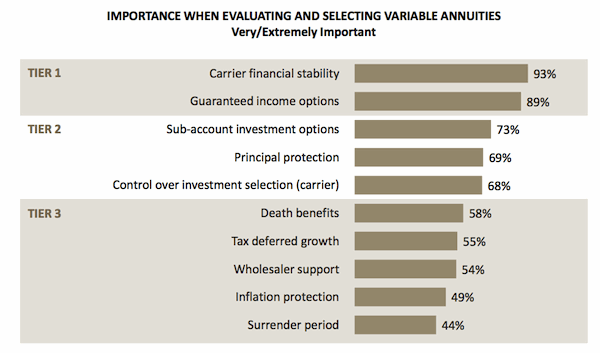When Ohio National Life introduces a new version of its ONCore variable annuity early next year, the contract will sport a rich living benefit. Its GLWB will offer an 8% annual deferral bonus and a single-life payout of 5.25% at age 65, according to the prospectus. The initial rider fee is 110 basis points a year.
How can the Cincinnati-based insurer afford to offer this alluring value proposition? Because it requires contract owners to allocate much of their money to three volatility-managed portfolios from TOPS, an ETF portfolio manager.
And if the strategy pays off for Ohio National, this type of product design could become the template for the VA industry going forward.
The portfolios, called TOPS Protected ETF Portfolios (Balanced, Moderate Growth and Growth), all contain, besides a foundation of ETFs, a futures-based hedging strategy that aims to cut off extreme performance, especially on the downside.
“Our goal is to get 75% up-capture and 25% down-capture over time,” said Michael McClary, TOPS’ chief investment officer. “If the market goes dead straight up, we won’t get 100% of it. But when it goes down we won’t go down as much.”
The hedging strategy inside those funds isn’t TOPS’ work, however. It’s the work of actuaries at the fund subadvisor, Milliman. It involves buying short equity index futures when the market goes up and selling them when the market goes down.
As Milliman’s Kamilla Svajgl said in a presentation at the Society of Actuaries conference on Equity-Based Insurance Guarantees Conference last week in Chicago, “It’s like having an airbag in your car. You have protection.”
A relatively new idea
Equity market volatility is Topic A these days. (On Monday, the DJIA dropped 2.11%.) Whether or not volatility is historically high, or simply feels high, or seems more dramatic because the market averages are inflated, or is aggravated by high frequency trading, it’s hard to say.
But, real or perceived, volatility scares clients. It can presage market collapses and, when it does, it can create mayhem for VA issuers by raising reserve requirements. Prudential alone took a $435 million charge in third quarter 2011 to strengthen its reserves due to the negative impact of falling equity prices on its living benefit guarantees and deferred acquisition costs (DAC).
Some insurers have decided that VAs are more trouble than they’re worth. John Hancock, a unit of Canada’s Manulife, last week said it would limit distribution of its fixed and variable annuities, after Manulife reported a $900 million charge related to annuity-related losses in the third quarter. MassMutual, Genworth Financial and ING have abandoned new variable annuity sales.
To stay in the game, other VA issuers have reduced their risk exposure through some combination of stingier benefits, higher prices, or risk-mitigating product designs that either change the client’s asset allocation automatically, or link fees to changes in the VIX or Treasury rates, or embed derivatives in the subaccounts themselves.
The Milliman strategy of adding a futures program to the ETFs in the TOPS portfolios is one of the latest ideas to be adopted by major insurers. (Milliman began promoting it over a year ago. See “Plugging Leaks in VA Guarantees,” RIJ, June 23, 2010.) .
So far, McClary says three insurance companies are using the TOPS Protected ETF portfolios. The first was Jefferson National for its flat-fee 300 investment-option VA. Then came Ohio National and Prudential (in variable life products). About $70 million has flowed into portfolios in just two months. Five more clients will launch products using the TOPS Protected portfolios within the next six months, he told RIJ, declining to name them.
How it works
For issuers of VAs with lifetime income guarantees, the beauty part of the Milliman index futures strategy is that it puts a low-cost risk management mechanism inside the subaccount investment.
To elaborate on Milliman’s automotive analogy: Under the old VA design, the insurer gave the contract owner a high-speed investment vehicle and then assumed the costs of building strong highway guardrails and buying collision coverage.
Under the new design, the vehicle is equipped with airbags and an automatic braking system whose costs are built into the price of the vehicle. “Accidents” are less likely and less violent.
“It’s like Driver’s Ed, where the passenger has a brake,” said McClary. The insurer’s risk and costs go down as a result. It can use the savings to pump up the product benefits, reduce the price, and/or fatten its bottom line.
As Milliman’s Kamilla Svajgl explained, this “sustainable model” requires five to 10% of the fund assets to be set aside as collateral for futures contracts. When the market goes up, Milliman enters into short equity futures contracts. If the market goes down, it will close out the short futures at a profit and add to the portfolio’s long position in ETFs.
It turns out that it’s better for the insurer to have the fund hedge itself by entering futures contracts than for the insurer to hedge by buying options and carrying them as volatile assets on its own balance sheet. (Cynics have said that the strategy shifts the cost of hedging onto the contract owner. But if the carrier returns the costs savings to the client in the form of richer benefits or lower expense ratios, the contract owner could benefit in the long run.)
Cheaper and safer
The cost savings can be game changing. “Before the financial crisis, a company might charge 65 bps for a GLWB rider and spend about 40 bps of that on hedging costs,” Svajgl said. “Since the financial crisis, a policyholder could pay 105 bps for the rider and it might cost 90 to over 105 bps to hedge it.
“But all of our vega [volatility] and most of our delta [changes in equity prices] is being done in the subaccounts. That reduces the overall hedge costs to manage the living benefits. So, if you charge 105 bps for the rider, only 50 to 60 bps will be spend on raw vega hedging or residual delta hedging.”
“If you bought put options,” McClary told RIJ, “you’d have to pay an option premium. But we’re using futures. You’re entering a position instead of paying a premium.”
In theory, this model can provide as much downside protection as the modified form of Constant Proportion Portfolio Insurance (CPPI) that Prudential uses in its popular Highest Daily variable annuities while being more nimble than CPPI at capturing the upside opportunity that often appears after a sharp market dip.
Prudential uses an algorithm that automatically moves assets from equities to investment grade bonds when equity prices fall and moves money back into equities as prices go back up. In contrast, because Milliman hedges the effects of a potential fall in equity prices by holding short equity futures, TOPS managers can reduce their funds’ equity risk exposure without actually selling depressed ETFs.
After prices have fallen, Milliman applies a capital protection strategy to help TOPS take advantage of bargains. A bit like a mountain climber who has driven pitons into the rock to limit the distance he can fall, Milliman sells appreciated short futures whenever the market drops more than 10% and uses the profits to provide cash for ETF purchases to shore up the funds’ equity allocation.
This futures-based rebalancing strategy demonstrated its value during the August 8 collapse in equity prices, when the S&P 500 Index dropped 6.65% and the equity exposure of the TOPS Protected portfolios had dropped to just 30% at one point.
“But our system then can reset the capital protection, reinvesting the cash profits from hedges into long ETFs, so that we don’t stay at 30% long forever and miss the opportunity for market growth,” McClary said. “Some strategies that include a hedge can effectively become very expensive money market accounts. It is our goal to avoid that.” The Protected portfolios returns for August 8 ranged from -0.81% to a positive 1.52%.
No free lunch
Of course, none of this financial engineering tames or beats the market, but merely shaves off the tail risk from an aggressive portfolio. According to Milliman’s analysis of “1,000 stochastically generated real world scenarios based on 30 years of daily returns for indices and interest rates,” a portfolio equipped with its protection method had half the average annualized volatility of an unprotected fund while lagging in average return by just 95 basis points, 7.66% to 8.51%.
Interestingly, the data shows that the protection works better during portfolio decumulation than during the accumulation stage. The average annual internal rate of return of an aggressive portfolio decumulating over 30 years was 6.86% for the protected portfolio and only 6.06% for the unprotected portfolio. Hedging appears to pay for itself and more by buffering the effects of sequence risk during retirement drawdown, when selling depressed assets can accelerate portfolio ruin.
“We are solving a sequence of return problem,” Svajgl told RIJ. She envisioned a time when every mutual fund or separate account portfolio has a built-in hedging strategy.
“I think we’re in a transitional period,” she said. “It used to be that Volvo was the only car company that talked about safety. Nobody else wanted to talk about safety because it reminded people of the danger of driving. But in the ‘new normal,’ it’s OK to talk about safety. I think we’ll reach a point where, just as people wouldn’t imagine getting into a car without air bags, they won’t imagine getting into a fund without a protection mechanism.”
© 2011 RIJ Publishing LLC. All rights reserved.





